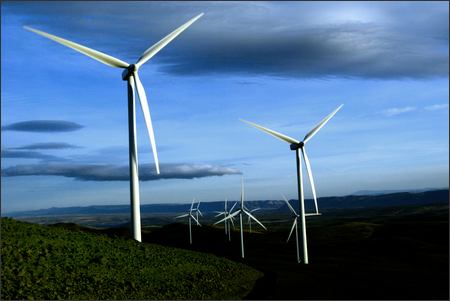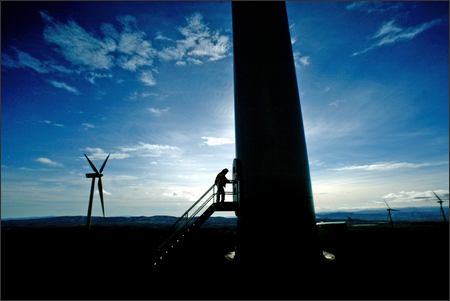forum
library
tutorial
contact

Clean vs. Dirty is only Part
of Renewable Energy Debate
by Lisa Stiffler
Seattle Post-Intelligencer, October 30, 2006
|
the film forum library tutorial contact |

|
Clean vs. Dirty is only Part
by Lisa Stiffler
|
 The slogans are simple:
The slogans are simple:
Higher electrical bills or utilities free to save ratepayers money.
In the muddle of initiatives and measures that clutter the Nov. 7 ballots, those for and against Initiative 937 are hoping to persuade voters with these basic concepts.
But that's only the tip of the wind turbine.
Those in favor of I-937 argue that regulations are needed to force utilities to grow in ways that won't worsen global warming by releasing heat-trapping gases created by burning fossil fuels. They say the requirements will lead to better energy conservation, such as education on saving energy and incentives for fluorescent light bulbs and efficient appliances.
"It's our opportunity to take control of our energy future," said Chris McCullough, campaign manager for Yes on I-937.
But many utilities bridle at a state mandate dictating their operations.
"We want to keep our decisions local and be able to determine what is best for our utility," said Rita Bjork, spokeswoman for the Grant County Public Utility District.
I-937 would require utilities with 25,000 or more customers -- currently 17 of the state's 63 utilities, including Seattle City Light and Puget Sound Energy -- to meet specific renewable energy goals. About 90 percent of the state's utility customers would be affected.
More than 20 other states have approved requirements for using renewable energy, and Oregon is developing its own program, which could have stricter standards than what's being considered here. If the Washington measure passes, by 2020 the larger utilities must get 15 percent of their energy from renewable sources -- primarily wind -- or from other sources including solar, wave or tidal power and methane captured from landfills and dairy cow manure.
 One of the key sticking points for I-937's opponents is the exclusion of hydropower from that list.
Initiative supporters said they didn't include hydropower because there are no major dam projects in the works, and the measure is about encouraging the development of new environmentally friendly power supplies.
One of the key sticking points for I-937's opponents is the exclusion of hydropower from that list.
Initiative supporters said they didn't include hydropower because there are no major dam projects in the works, and the measure is about encouraging the development of new environmentally friendly power supplies.
There are requirements for the utilities to squeeze more energy from conservation measures -- an area in which tremendous gains have been seen in the past two decades.
The measure includes penalties and escape clauses. A utility can meet the standards by spending 4 percent of its annual revenue on renewables, even if it doesn't reach the percentage goal. But utilities not meeting the benchmarks would be charged $50 for each megawatt-hour by which they miss the target.
The cost of the measure is murky. The state's fiscal office has predicted a $167,000 increase annually in administrative costs for state agencies.
But what it means to business and residential electrical bills is uncertain.
The business-oriented Washington Research Council took the 4 percent spending cap, looked at recent energy costs, assumed all the utilities would spend up to the cap, and concluded that utilities could expect a $185 million annual increase in costs -- an increase they said was likely to hit ratepayers in their power bills.
Initiative supporters say not all the utilities will spend up to the cap and that the measure could save money because of fluctuations in the price of fossil fuels such as coal, gas and oil.
Even impartial experts can't put a price on the measure.
The price of turbines jumped dramatically in recent years, but that's partly because of increased costs in steel and other construction materials. More turbine manufacturing facilities are being built, increasing supply. A federal tax credit that has made wind power more affordable is set to expire, but there are expectations that it will be renewed. And there's interest in policies that will one day penalize the release of global-warming gases -- such as those produced by coal plants.
There are a lot of factors to consider when you look at energy costs, said Jeff King, senior resource analyst with the Northwest Power and Conservation Council, an advisory agency. That doesn't mean the initiative necessarily would result in higher prices.
"It's easy to imagine the future where it could be lower cost," he said.
Manure could be a cash cow
When he's not tending his Black Angus cattle and Christmas tree farm in Snohomish County, Dale Reiner is thinking about manure.
Reiner is the president of Qualco Energy, a non-profit consortium that's building a facility to create power from poop.
"Everything that's organic, people and everything, when they deteriorate, they give off a methane gas," Reiner said. "That's what we're after."
Methane -- a potent global-warming gas -- can be burned and converted to energy. Qualco Energy is building pipes to transport dairy cow manure to its "bio-digester," which will facilitate the production and capture of methane gas. The bio-digester still needs to be built, but the project could be running next year, Reiner said. It's expected to cost between $1.5 million and $3 million and could create enough power to supply hundreds of homes.
Initiative supporters and some experts say small projects such as this could crop up around the region if the measure passes.
"You eliminate a waste problem, plus you get some energy," King said. "I suspect if the (requirements) are adopted in Washington and Oregon, we'll see that stuff being rapidly developed."
At this point, the largest potential source of renewable energy comes from wind, which currently provides about 1 percent of the state's energy supply. How much wind energy is available and at what cost is hotly debated. The equation is complicated by the inherently unpredictable and irregular nature of wind energy. To make it work, wind has to be paired with more reliable power sources.
I-937 opponents insist that the numbers don't add up when it comes to wind energy, but others say the technology has made significant advances and turbines are producing more power than even a decade ago. And the solution isn't restricted to Washington -- there is great potential for wind power from British Columbia, experts say.
About 1,730 average megawatts of energy could be produced by 2020 through the construction of new turbines, satisfying close to 40 percent of the projected growth in demand. And conservation could cover slightly less than half the increased demand, according to the Northwest Power and Conservation Council.
In Washington, wind-turbine construction has focused on the eastern half of the state. The projects are not uniformly embraced.
A Kittitas Valley wind project was rejected by the county board of commissioners, but the company proposing the endeavor, Horizon Wind Energy, is still trying to get approval from a state energy council and Gov. Chris Gregoire. Opponents say the turbines -- which can measure two-thirds the height of the Space Needle -- are eyesores.
To help win over detractors, Horizon Wind cut the number of turbines from more than 120 to 65. It has offered to stop their spinning for the brief periods when the sun is at such an angle that it creates flickering shadows that can disturb nearby residents.
Hydropower only part of equation
In the late 1930s, Northwesterners began harnessing the power of water through the construction of massive dams on the Columbia and Snake rivers. Now hydropower supplies about 68 percent of the state's energy.
"We've been very lucky," McCullough said. "We have a great, clean cheap energy supply from our rivers." Seattle City Light, for example, gets 87 percent of its power from water, 4 percent from wind and the rest from nuclear plants and natural gas. Demand is growing at a rate of slightly less than 1 percent annually -- so nearly all of its growth would need to be in renewable power to meet the goals.
"The numbers are staggering when you try to get to 15 percent," said Dave Muller, manager of the Lewis County PUD. The county gets less than 1 percent of its energy from wind.
"We think that the initiative is actually misleading because it refers to renewable energy, but it doesn't include hydropower," said Chris McCabe, governmental affairs director for the Association of Washington Business.
Under the initiative, utilities could get credit toward the 15 percent goal from upgrades that make dams more efficient.
Some say that although the region has been blessed by the relatively inexpensive power generated by the dams, it has stifled the development of other sources.
"It's very difficult for any alternative power source to compete with dams built on the Columbia River by the government 50 years ago," Reiner said.
The Bonneville Power Administration, the federal agency that operates many of the region's dams, is examining how much energy could come from wind, balanced with hydropower.
Although some public utility districts have come out in opposition to the initiative, a majority voted to endorse the measure through an umbrella organization called the Washington Public Utility Districts Association.
Serious problems with the measure were resolved shortly before it was made final, said Dean Boyer, the association's spokesman. That included adding the 4 percent spending cap and reductions in the amount of state regulation being proposed.
I-937 could cost some utilities more money, he said, but the group supports it.
"It's also clear that most -- if not all -- of the PUDs in the state are already looking at renewable power sources regardless of the initiative itself," Boyer said, "because it's the right thing to do from an environmental and a business perspective."
learn more on topics covered in the film
see the video
read the script
learn the songs
discussion forum
